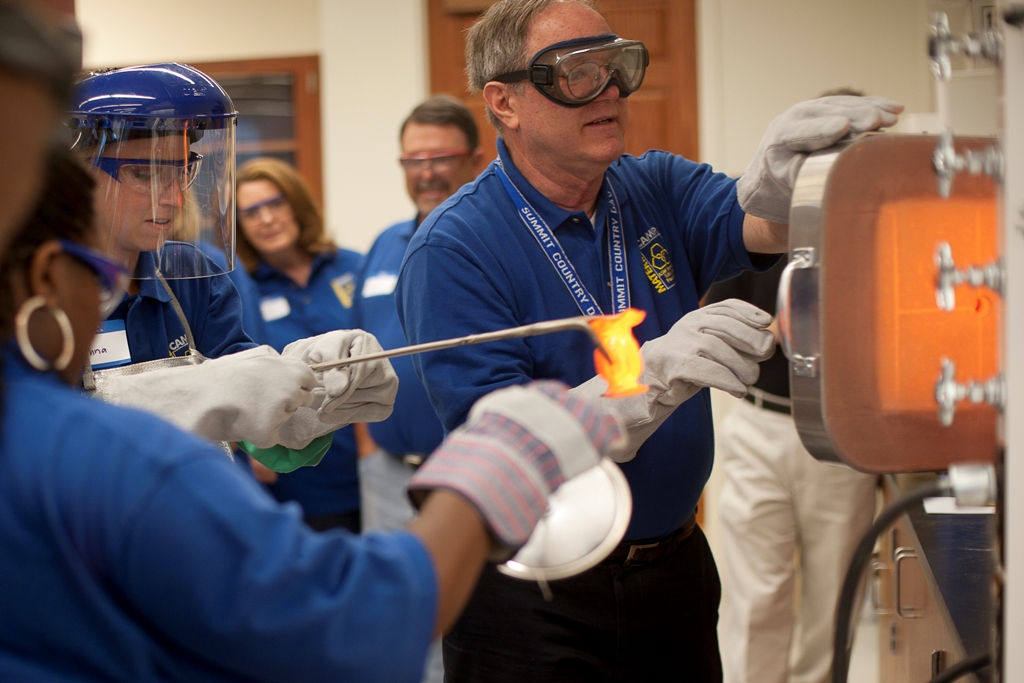Dressed in a royal blue golf shirt – one which identically matches her 15 classmates – Deborah Harper marches, metal tongs in hand, toward a box furnace heated to 1,200 degrees inside a University of Alabama laboratory.
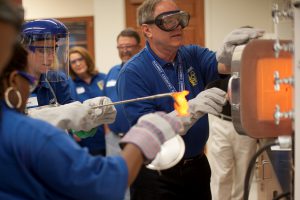
Using the tongs she removes the pot, which she earlier constructed, placing it in a metal bucket filled with newspaper. The newspaper temporarily flares, as expected, but a quick covering with the accompanying lid snuffs the flame.
Harper is not just a science student. She’s a science teacher at Amelia Love Johnson High School. She is attending, along with other middle and high-school science teachers, the ASM Materials Camp, a week-long training event earlier hosted by The University of Alabama and designed to teach teachers new ways to engage their students in science.
The experiment with the pots, only one in a host of hands-on exercises conducted by the teachers at the ASM Materials Camp, teaches concepts about corrosion and solid-state chemistry through materials science.
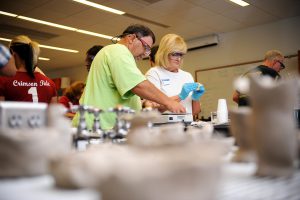
Organized nationally by ASM International’s Materials Education Foundation and supported by an Office of Naval Research grant, the camp is one of several initiatives where The University of Alabama reaches into the K-12 classrooms through its direct interaction with K-12 teachers. Dr. Martin Bakker, associate professor of chemistry in UA’s College of Arts and Sciences, served as the camp’s coordinator.
Chuck Hayes, director of ASM’s Education Foundation, calls K-12 teachers the “heroes of America,” along with, he says, police, nurses and the military. “These teachers are preparing students for careers that don’t even exist today.”
Bakker has visited, along with some of his graduate students, these heroes within their K-12 classrooms, increasing the rapport between K-12 and UA and spreading the word about the camp. He says the graduate students were flattered by the receptions they receive, time and again, from the young students.
“It’s really cool to them to attend an elementary school class and have those young people absolutely adore you because of what you’re doing,” Bakker says. “Who can’t get a buzz out of that?” He says he sees such outreach partnerships growing in interest from both sides of the equation.
“I’ve seen so many of our young faculty who not only want to do this, but who have push from funding agencies wanting them to do this.”
CRINGING NO MORE
Allison Guy, a reading/literacy coach at Spanish Fort Elementary School, admits she once needed a little push when it came to developing her writing skills.
“I actually cringed at the thought of sitting down to write, professionally, and did not make time for personal writing,” says Guy.
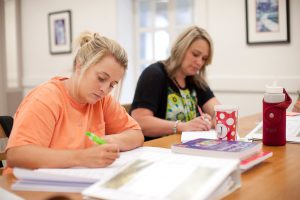
But if teachers, like Guy, are cringing at the sight of a blank page, imagine the feeling their students have when approaching a writing assignment. That’s a basic premise behind the Longleaf Writing Project – you must write to teach someone to write.
Housed in The University of Alabama’s College of Education, The Longleaf Writing Project serves as the western Alabama site of the National Writing Project, a professional development institute with nearly 200 sites nationwide.
There’s at least one startling difference between it and many teacher-training sessions.
Walking into a typical teacher workshop, you’re often bombarded with sounds – talking, scissors cutting, keyboards clicking, papers rustling. But at the Longleaf Writing Project, it’s the quiet that almost resonates.
Teachers are silently putting down their thoughts and ideas using two of today’s most underrated creative tools – pen and paper.
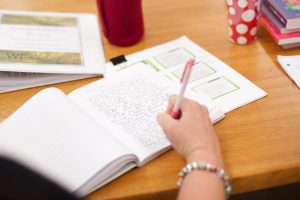
This summer institute gives teachers opportunity to explore their own development as a writer, learn about writing-instruction research and to develop classroom strategies for writing instruction. They can then take these techniques back to their schools and share with their colleagues.
Teachers teaching teachers is the strength, coordinators say, of this 40-year-old program.
“It’s a fun and rigorous time for exploring writing from personal and professional perspectives,” says Dr. Diane Sekeres, UA associate professor of literacy education and one of the LWP co-directors. “The end purpose, of course, is to have high quality writing instruction in classrooms to help students learn to think through writing and to express themselves competently in many different writing genres,” she says.
And, for Allison Guy, the quiet of writing no longer intimidates.
“Instead of dreading picking up the pen, I actually began to look forward to it,” Guy says. “I learned so much about myself as a writer that summer. I discovered a voice that I didn’t know was inside of me and became more confident in my writing.”
NOW, THAT’S SMART
From the time-honored tools of pen and paper, to the high-tech world of smartphone applications, K-12 teachers traveled to UA during the summer of 2011 for training on both ends of the spectrum.
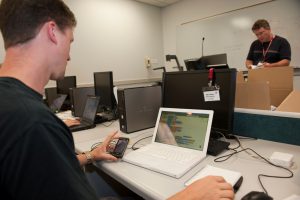
While most apps are for entertainment purposes, developers are also looking to apps to solve every-day problems. See a need, app a need. As technology evolves, high school teachers can use smartphones to keep students engaged through what they use most: apps.
The Computer Science for High School program, an initiative sponsored by Google, aims to help teachers by promoting computer science education. Through a three-day workshop held at UA in July, 20 Alabama high school teachers learned about emerging computer science curricula and how to develop Android applications. The teachers took their knowledge back to their schools and developed apps for their classrooms and introduced computer science concepts to their students.
The UA workshop focused on Scratch and Google’s App Inventor. Scratch, a programming language geared toward young people, allows users to create interactive programs, animations, games, music and art for web sharing. Google’s App Inventor is a visual block language that can be used to create Android apps.
In addition to the hands-on learning, another objective of the workshop was to build a network of teacher collaboration throughout the state, says Dr. Jeff Gray, associate professor of computer science at UA. To aid with such collaboration, UA is hosting the teacher-created apps on the workshop web page.
“Because so few schools are able to cover technology adequately, it is important to help the teachers build a network to promote computational thinking in secondary education,” says Gray.
UA is one of a few universities to receive the $15,000 Google grant, and it is one of only two schools in the Southeast receiving the honor. Gray plans to apply again next year with the intention of expanding it for teachers throughout the Southeast.
TRAINING TAKES A MOON WALK
Another UA training event expanded well beyond the Southeast … even reaching outside the Earth’s atmosphere.
Only a dozen Americans have ever landed on the moon, but thousands of middle- and high-school students get to experience the wonder of space exploration, thanks in part to the Southeast Consortium for Minorities in Engineering Summer Institute’s teacher training.
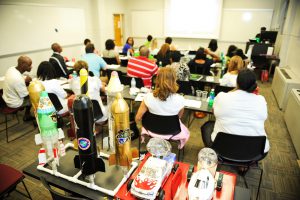
Through the 2011 summer program held at UA, teachers received NASA certification allowing them to use the space program’s moon rocks in their classrooms.
These teachers took part in a seminar taught by Dr. William O. Robertson, aerospace education specialist with NASA’s Marshall Space Flight Center in Huntsville. This certification program allows NASA representatives to show teachers how to incorporate the moon rock samples into earth sciences and planetary studies, Robertson says.
Donita Legoas, a teacher at Pine Hill Middle School in Augusta, Ga., says the session helped her become more familiar with free educational resources available to teachers through NASA.
“I learned hands-on, minds-on activities to use with my students and where I can go for assistance if I need it in the future.”
NASA offers the training as a way to share the moon rocks – described by Robertson as a “national treasure” – with as many people as possible.
The SECME Summer Institute, hosted by the UA College of Engineering, contributes perspectives on equity and inclusion initiatives with a focus on learning and performing sciences, technology, engineering and math.
About 90 middle and high school math and science teachers participated in the June 2011 institute, participating in activities ranging from space rocks in the classroom and magical science labs to geodesic domes and Tai-Chi mathematics.
SCIENCE: MORE THAN VOCABULARY
Ben Miller, a teacher of high school science and physics and a 22-year educator, said the UA-hosted ASM Materials Camp, provides participants a different perspective to science than what’s often viewed.
“Science is much more than vocabulary, and this workshop is getting at more of the practical applications,” Miller says.
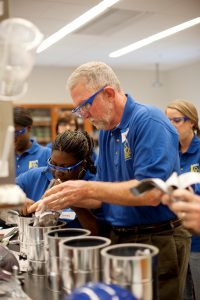
Paige Spencer, a teacher at Northridge High School, says helping her students see the application is key to engaging them.
“If you do activities that are relevant to the real world and give them a chance to get their hands dirty, it’s not difficult to get students excited about science. They’re doing a great job at this camp swapping up the teaching and the labs. We’re doing lots of different things. Since it’s materials science, the activities connect to things the kids know about.”
Hayes says the nation’s biggest challenge is not related to taxes or welfare-reform issues, but is the looming shortage of a sufficiently trained workforce, and that helping young people see the possibilities of science and technology careers is key to overcoming the crisis.
“We want the students to see that engineering, math or science is something that maybe could be on their list of possible careers – in addition to the NBA and a rock star,” he says with a quick smile.
“For my money, this,” says Hayes, with a slight nod toward the teachers working within the UA laboratory, “is tomorrow.”
Chris Bryant, Suzanne Dowling, Linda Hill and Mary Wymer contributed to this report.
Contact
Sarah Colwell, College of Arts and Sciences, 205/348-8539, sccolwell@as.ua.edu
